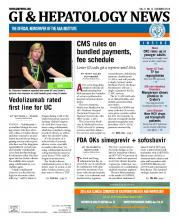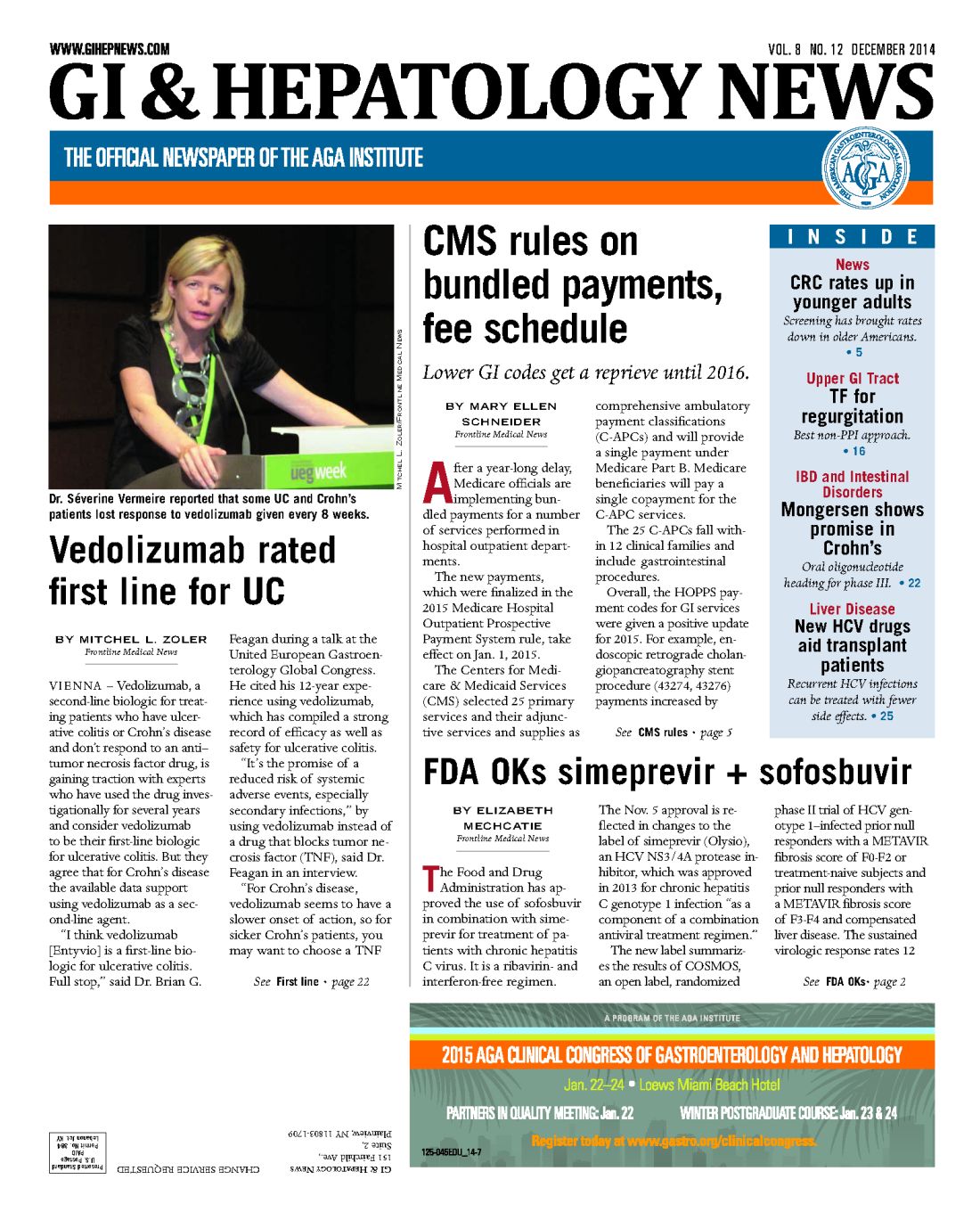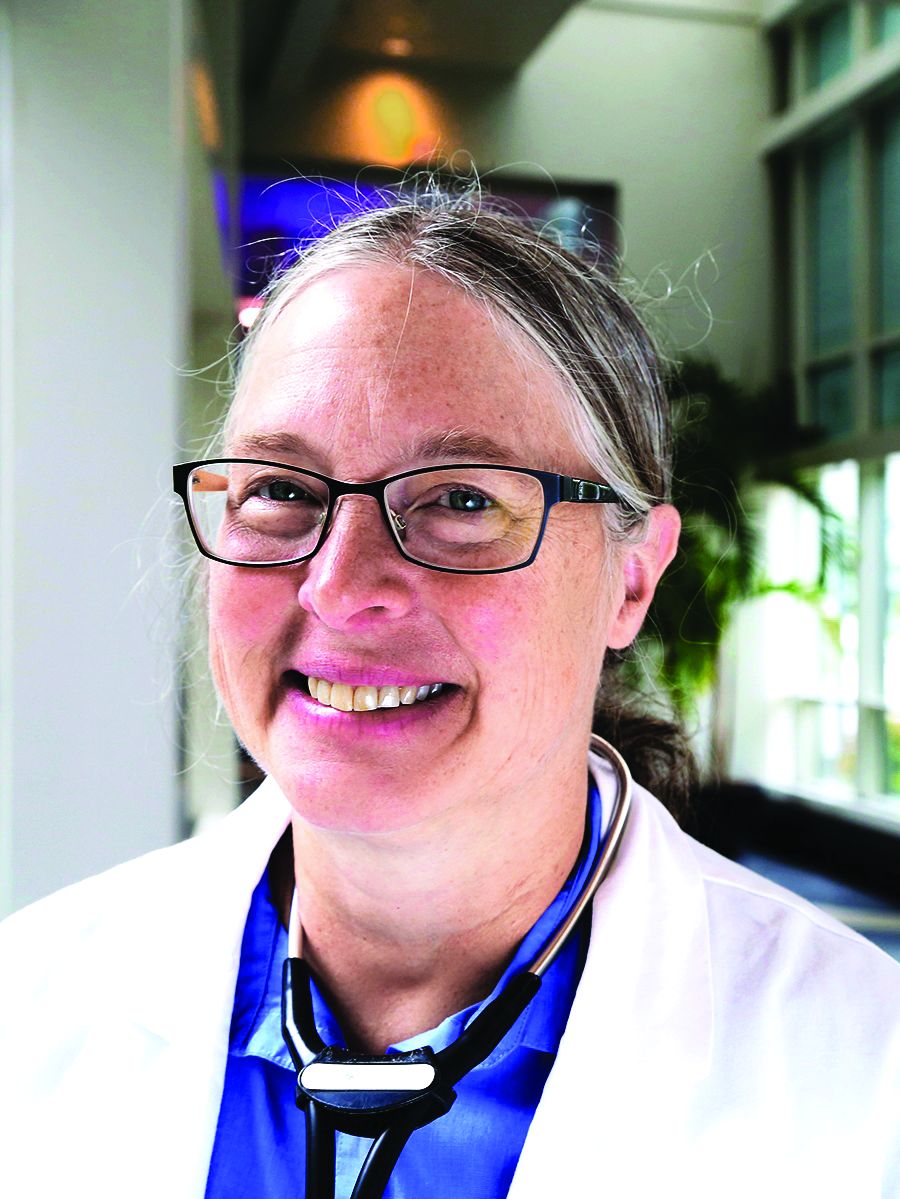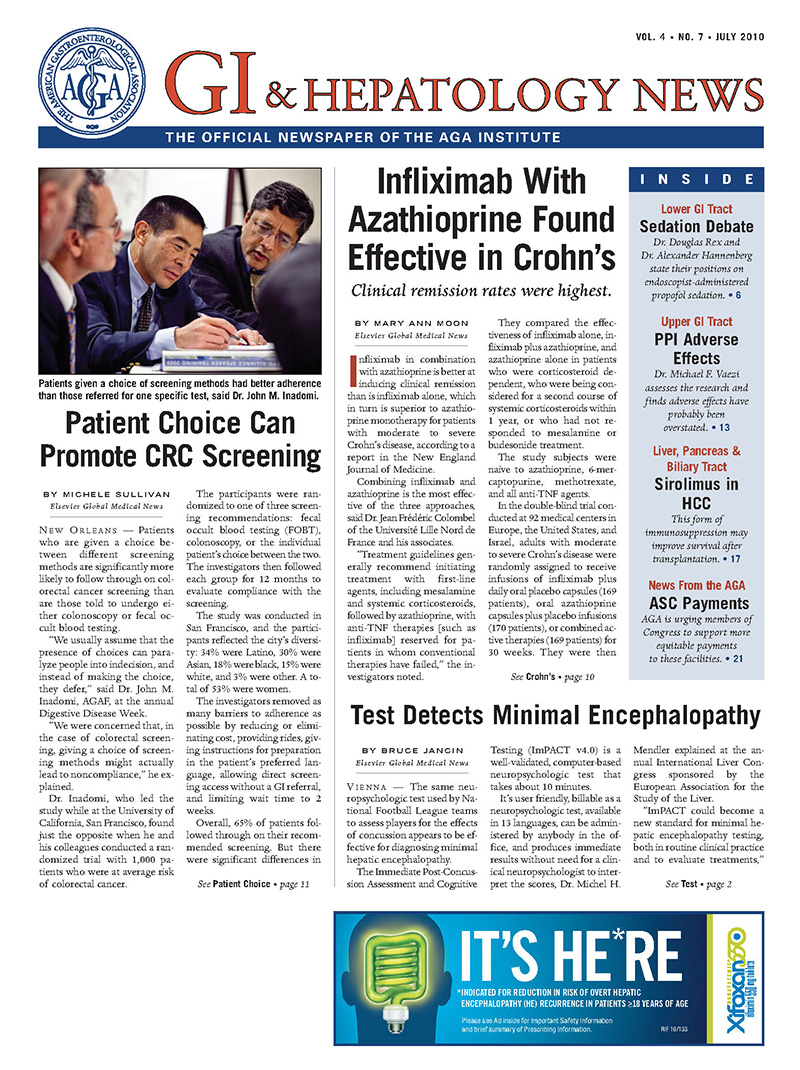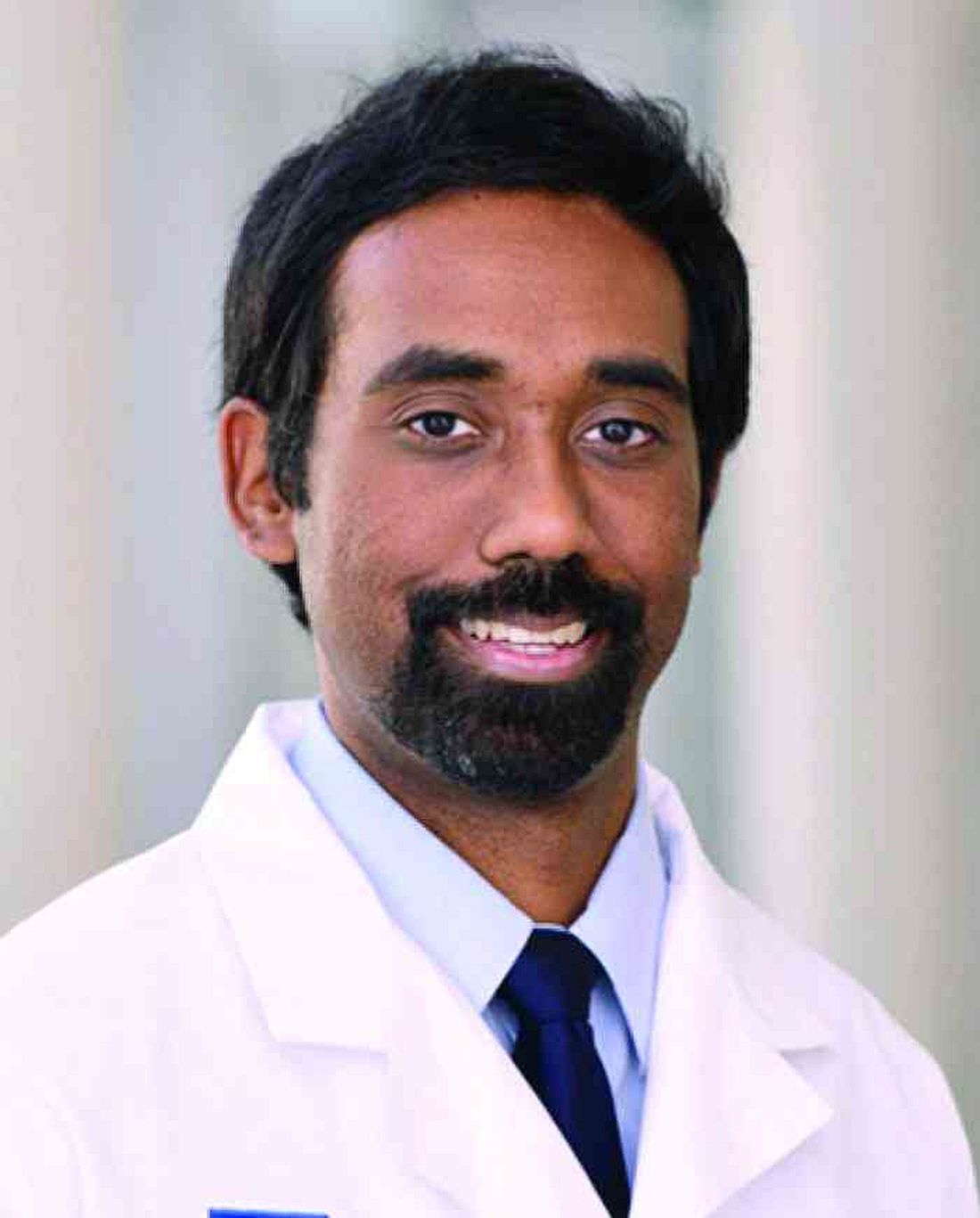User login
Flashback to 2015
In the early 1970s, clindamycin had only been on the market for a few years when patients taking the antibiotic began to present with diarrhea and associated colitis. Initial attempts to culture a pathologic organism were unsuccessful, so other possible pathophysiologic mechanisms, including medication toxicity, altered bacterial flora, or the emergence of a new bacterial or viral pathogen were considered. Patients were initially given treatments similar to those for ulcerative colitis, with systemic and topical steroids and colectomy. Several years later, Clostridium difficile infection (CDI) was identified as the culprit, and these presentations became increasingly common in U.S. hospitals, and later in community settings.
Incidentally, the organism had been discovered years earlier, in 1935, by a group of scientists studying normal bacterial flora in neonates, but it was not known to be pathogenic in adults. By 2007, CDI had become the most common cause of health care–associated infection in U.S. hospitals. This prompted the Centers for Disease Control and Prevention to begin active population- and laboratory-based surveillance for C. difficile through its Emerging Infections Program (EIP) with the goal of more accurately assessing disease burden, incidence, recurrence, and mortality by capturing data across the spectrum of health care delivery settings. The April 2015 issue of GI & Hepatology News highlighted a report of 2011 CDC data from 10 EIP sites (N Engl J Med. 372;9:825-34), demonstrating that CDI was responsible for nearly half a million infections and 29,000 deaths in that year across sites, with the hypervirulent NAP1 strain found to be more prevalent among health care–associated than community-associated infections.
Treatment of CDI continues to evolve. With increased use of fecal microbiota transplantation, emerging evidence regarding the efficacy of other novel therapies such as the monoclonal antibodies actoxumab and bezlotoxumab (providing passive immunity to toxins A and B, respectively), and development of preventive vaccines (currently in phase 2 trials), there is hope on the horizon of being able to improve patient outcomes and reduce the burden of CDI on the health care system.
Megan A. Adams, MD, JD, MSc, is a clinical lecturer in the division of gastroenterology at the University of Michigan, a gastroenterologist at the Ann Arbor, Mich., VA, and an investigator in the VA Ann Arbor Center for Clinical Management Research. She is an associate editor of GI & Hepatology News.
In the early 1970s, clindamycin had only been on the market for a few years when patients taking the antibiotic began to present with diarrhea and associated colitis. Initial attempts to culture a pathologic organism were unsuccessful, so other possible pathophysiologic mechanisms, including medication toxicity, altered bacterial flora, or the emergence of a new bacterial or viral pathogen were considered. Patients were initially given treatments similar to those for ulcerative colitis, with systemic and topical steroids and colectomy. Several years later, Clostridium difficile infection (CDI) was identified as the culprit, and these presentations became increasingly common in U.S. hospitals, and later in community settings.
Incidentally, the organism had been discovered years earlier, in 1935, by a group of scientists studying normal bacterial flora in neonates, but it was not known to be pathogenic in adults. By 2007, CDI had become the most common cause of health care–associated infection in U.S. hospitals. This prompted the Centers for Disease Control and Prevention to begin active population- and laboratory-based surveillance for C. difficile through its Emerging Infections Program (EIP) with the goal of more accurately assessing disease burden, incidence, recurrence, and mortality by capturing data across the spectrum of health care delivery settings. The April 2015 issue of GI & Hepatology News highlighted a report of 2011 CDC data from 10 EIP sites (N Engl J Med. 372;9:825-34), demonstrating that CDI was responsible for nearly half a million infections and 29,000 deaths in that year across sites, with the hypervirulent NAP1 strain found to be more prevalent among health care–associated than community-associated infections.
Treatment of CDI continues to evolve. With increased use of fecal microbiota transplantation, emerging evidence regarding the efficacy of other novel therapies such as the monoclonal antibodies actoxumab and bezlotoxumab (providing passive immunity to toxins A and B, respectively), and development of preventive vaccines (currently in phase 2 trials), there is hope on the horizon of being able to improve patient outcomes and reduce the burden of CDI on the health care system.
Megan A. Adams, MD, JD, MSc, is a clinical lecturer in the division of gastroenterology at the University of Michigan, a gastroenterologist at the Ann Arbor, Mich., VA, and an investigator in the VA Ann Arbor Center for Clinical Management Research. She is an associate editor of GI & Hepatology News.
In the early 1970s, clindamycin had only been on the market for a few years when patients taking the antibiotic began to present with diarrhea and associated colitis. Initial attempts to culture a pathologic organism were unsuccessful, so other possible pathophysiologic mechanisms, including medication toxicity, altered bacterial flora, or the emergence of a new bacterial or viral pathogen were considered. Patients were initially given treatments similar to those for ulcerative colitis, with systemic and topical steroids and colectomy. Several years later, Clostridium difficile infection (CDI) was identified as the culprit, and these presentations became increasingly common in U.S. hospitals, and later in community settings.
Incidentally, the organism had been discovered years earlier, in 1935, by a group of scientists studying normal bacterial flora in neonates, but it was not known to be pathogenic in adults. By 2007, CDI had become the most common cause of health care–associated infection in U.S. hospitals. This prompted the Centers for Disease Control and Prevention to begin active population- and laboratory-based surveillance for C. difficile through its Emerging Infections Program (EIP) with the goal of more accurately assessing disease burden, incidence, recurrence, and mortality by capturing data across the spectrum of health care delivery settings. The April 2015 issue of GI & Hepatology News highlighted a report of 2011 CDC data from 10 EIP sites (N Engl J Med. 372;9:825-34), demonstrating that CDI was responsible for nearly half a million infections and 29,000 deaths in that year across sites, with the hypervirulent NAP1 strain found to be more prevalent among health care–associated than community-associated infections.
Treatment of CDI continues to evolve. With increased use of fecal microbiota transplantation, emerging evidence regarding the efficacy of other novel therapies such as the monoclonal antibodies actoxumab and bezlotoxumab (providing passive immunity to toxins A and B, respectively), and development of preventive vaccines (currently in phase 2 trials), there is hope on the horizon of being able to improve patient outcomes and reduce the burden of CDI on the health care system.
Megan A. Adams, MD, JD, MSc, is a clinical lecturer in the division of gastroenterology at the University of Michigan, a gastroenterologist at the Ann Arbor, Mich., VA, and an investigator in the VA Ann Arbor Center for Clinical Management Research. She is an associate editor of GI & Hepatology News.
Flashback to 2014
The development of therapies for chronic hepatitis C viral (HCV) infection has been a highlight of progress in hepatology and infectious disease over the last 25 years. From initial empiric approaches with interferon and ribavirin, to targeted and custom designed direct-acting antivirals (DAAs), there has been rapid improvement in efficacy and side effect profiles. Since we are dealing with a viral infection, loss of viremia after stopping therapy (sustained viral response, SVR) has been the marker of therapeutic success. SVR, however, is still a surrogate for clinical outcome and the analysis of 5-year follow-up in the December 2014 issue reported that in patients with SVR there was a reduction in risk of death, hepatocellular carcinoma, and liver transplantation.
Observational studies have the potential for significant biases as decisions to treat are frequently based on the likelihood of a successful outcome. A randomized clinical trial for DAAs compared to control would of course be unethical at this stage. The scale of use of DAAs should allow a clear answer to this question within the next 2 years.
The development of therapies for chronic hepatitis C viral (HCV) infection has been a highlight of progress in hepatology and infectious disease over the last 25 years. From initial empiric approaches with interferon and ribavirin, to targeted and custom designed direct-acting antivirals (DAAs), there has been rapid improvement in efficacy and side effect profiles. Since we are dealing with a viral infection, loss of viremia after stopping therapy (sustained viral response, SVR) has been the marker of therapeutic success. SVR, however, is still a surrogate for clinical outcome and the analysis of 5-year follow-up in the December 2014 issue reported that in patients with SVR there was a reduction in risk of death, hepatocellular carcinoma, and liver transplantation.
Observational studies have the potential for significant biases as decisions to treat are frequently based on the likelihood of a successful outcome. A randomized clinical trial for DAAs compared to control would of course be unethical at this stage. The scale of use of DAAs should allow a clear answer to this question within the next 2 years.
The development of therapies for chronic hepatitis C viral (HCV) infection has been a highlight of progress in hepatology and infectious disease over the last 25 years. From initial empiric approaches with interferon and ribavirin, to targeted and custom designed direct-acting antivirals (DAAs), there has been rapid improvement in efficacy and side effect profiles. Since we are dealing with a viral infection, loss of viremia after stopping therapy (sustained viral response, SVR) has been the marker of therapeutic success. SVR, however, is still a surrogate for clinical outcome and the analysis of 5-year follow-up in the December 2014 issue reported that in patients with SVR there was a reduction in risk of death, hepatocellular carcinoma, and liver transplantation.
Observational studies have the potential for significant biases as decisions to treat are frequently based on the likelihood of a successful outcome. A randomized clinical trial for DAAs compared to control would of course be unethical at this stage. The scale of use of DAAs should allow a clear answer to this question within the next 2 years.
Flashback to 2013 and the attempt to repeal the SGR formula
This month, our “Flashback” article highlights Congress’s long-term attempt to repeal the Sustainable Growth Rate formula for physician reimbursement and base our payments on patient health outcomes. Although the Medicare Access and Quality Improvement Act of 2013 (highlighted in our 2013 article) sponsored by Rep. Michael Burgess and passed unanimously in the House of Representatives did not become law, it did set the stage for the passage of H.R.2 – the Medicare Access and CHIP Reauthorization Act of 2015 (MACRA). Also sponsored by Rep. Burgess and passed with bipartisan support, MACRA has now become the foundation for our transition from fee-for-service reimbursement to value-based care.
In just 2 short years, we have all become familiar with terms like MIPS (Merit-based Incentive Payment System) and APMs (Alternative Payment Models). These two methods of reimbursement will become the backbone of a growing percentage of our revenue going forward. Gastroenterologists should embrace these programs and work to find our unique position in the health care value chain.
Do not reject the transition to value. Medicine is no different from most other industries in which value for the consumer is the major driver of business model change. Although physicians pride themselves on practicing quality medicine, quality cannot be our only focus. The cost of the services we provide must also be considered. Together, higher quality and lower cost drive value.
Our focus on cost should not only be directed at the specific services we ourselves provide, but should also be aimed at the total cost of care for the population of patients we are serving. We must be able to demonstrate to those who are taking the risk for payment that the real value of our services lies in improving the health and lowering the overall cost of care for a population of patients.
Larry R. Kosinski, MD, MBA, AGAF, FACG, is a managing partner of Illinois Gastroenterology Group, the Clinical Private Practice Councillor for the AGA, and serves on its Governing Board. He is president and chief medical officer of Project Sonar and an Associate Editor of GI & Hepatology News.
This month, our “Flashback” article highlights Congress’s long-term attempt to repeal the Sustainable Growth Rate formula for physician reimbursement and base our payments on patient health outcomes. Although the Medicare Access and Quality Improvement Act of 2013 (highlighted in our 2013 article) sponsored by Rep. Michael Burgess and passed unanimously in the House of Representatives did not become law, it did set the stage for the passage of H.R.2 – the Medicare Access and CHIP Reauthorization Act of 2015 (MACRA). Also sponsored by Rep. Burgess and passed with bipartisan support, MACRA has now become the foundation for our transition from fee-for-service reimbursement to value-based care.
In just 2 short years, we have all become familiar with terms like MIPS (Merit-based Incentive Payment System) and APMs (Alternative Payment Models). These two methods of reimbursement will become the backbone of a growing percentage of our revenue going forward. Gastroenterologists should embrace these programs and work to find our unique position in the health care value chain.
Do not reject the transition to value. Medicine is no different from most other industries in which value for the consumer is the major driver of business model change. Although physicians pride themselves on practicing quality medicine, quality cannot be our only focus. The cost of the services we provide must also be considered. Together, higher quality and lower cost drive value.
Our focus on cost should not only be directed at the specific services we ourselves provide, but should also be aimed at the total cost of care for the population of patients we are serving. We must be able to demonstrate to those who are taking the risk for payment that the real value of our services lies in improving the health and lowering the overall cost of care for a population of patients.
Larry R. Kosinski, MD, MBA, AGAF, FACG, is a managing partner of Illinois Gastroenterology Group, the Clinical Private Practice Councillor for the AGA, and serves on its Governing Board. He is president and chief medical officer of Project Sonar and an Associate Editor of GI & Hepatology News.
This month, our “Flashback” article highlights Congress’s long-term attempt to repeal the Sustainable Growth Rate formula for physician reimbursement and base our payments on patient health outcomes. Although the Medicare Access and Quality Improvement Act of 2013 (highlighted in our 2013 article) sponsored by Rep. Michael Burgess and passed unanimously in the House of Representatives did not become law, it did set the stage for the passage of H.R.2 – the Medicare Access and CHIP Reauthorization Act of 2015 (MACRA). Also sponsored by Rep. Burgess and passed with bipartisan support, MACRA has now become the foundation for our transition from fee-for-service reimbursement to value-based care.
In just 2 short years, we have all become familiar with terms like MIPS (Merit-based Incentive Payment System) and APMs (Alternative Payment Models). These two methods of reimbursement will become the backbone of a growing percentage of our revenue going forward. Gastroenterologists should embrace these programs and work to find our unique position in the health care value chain.
Do not reject the transition to value. Medicine is no different from most other industries in which value for the consumer is the major driver of business model change. Although physicians pride themselves on practicing quality medicine, quality cannot be our only focus. The cost of the services we provide must also be considered. Together, higher quality and lower cost drive value.
Our focus on cost should not only be directed at the specific services we ourselves provide, but should also be aimed at the total cost of care for the population of patients we are serving. We must be able to demonstrate to those who are taking the risk for payment that the real value of our services lies in improving the health and lowering the overall cost of care for a population of patients.
Larry R. Kosinski, MD, MBA, AGAF, FACG, is a managing partner of Illinois Gastroenterology Group, the Clinical Private Practice Councillor for the AGA, and serves on its Governing Board. He is president and chief medical officer of Project Sonar and an Associate Editor of GI & Hepatology News.
Flashback to 2012
It’s a whole new biosimilar world. In the April 2012 issue of GI & Hepatology News (GIHN) there was a small article on the issued Food and Drug Administration guidance on how to develop biosimilars. A biosimilar molecule must be structurally similar to the reference or originator product with the expectation that the safety and efficacy will be the same. The European Medicines Agency (EMA) established a legal framework for approving biologics in the European Union in 2003 and guidelines for approval in 2005 to 2006 with the first biosimilar approved in 2006 (somatropin [Omnitrope]).
The first monoclonal antibody biosimilar approved by the EMA was CT-P13 (infliximab-dyyb) in June 2013. There are now over 23 biosimilars approved for use in Europe. In 2012 there were no biosimilars on the market in the United States. This past year (2016) has been the year of the biosimilar with two of the four approved compounds used in inflammatory bowel disease – Inflectra (infliximab-dyyb, Hospira) April 2016 and Amjevita (adalimumab-atto, Amgen) September 2016 appearing.
The launch of these biosimilars raises a whole new series of questions. First and foremost for gastroenterologists – are the biosimilars truly similar in patients with inflammatory bowel disease? Adalimumab-atto was approved on the basis of two phase III studies in psoriasis and in rheumatoid arthritis and infliximab-dyyb was approved on the basis of studies in rheumatoid arthritis and ankylosing spondylitis. Other questions arise: 1. Can a patient who is doing well on the originator be safely switched to the biosimilar? 2. Can we use the same assays for drug monitoring? 3. Will use of biosimilars lead to a lower cost structure for patients and hospitals? 4. What are the regulations and guidelines for interchangeability? (GIHN March 2017) In the United States, development of biosimilars was slow to start but we expect to see an explosion in development of these agents in gastroenterology as the patents expire on the biologics currently in use.
Kim L. Isaacs, MD, PhD, is professor of medicine in the division of gastroenterology and hepatology at the University of North Carolina at Chapel Hill. She is codirector of the UNC Center for Inflammatory Bowel Disease. She is an Associate Editor for GI and Hepatology News.
It’s a whole new biosimilar world. In the April 2012 issue of GI & Hepatology News (GIHN) there was a small article on the issued Food and Drug Administration guidance on how to develop biosimilars. A biosimilar molecule must be structurally similar to the reference or originator product with the expectation that the safety and efficacy will be the same. The European Medicines Agency (EMA) established a legal framework for approving biologics in the European Union in 2003 and guidelines for approval in 2005 to 2006 with the first biosimilar approved in 2006 (somatropin [Omnitrope]).
The first monoclonal antibody biosimilar approved by the EMA was CT-P13 (infliximab-dyyb) in June 2013. There are now over 23 biosimilars approved for use in Europe. In 2012 there were no biosimilars on the market in the United States. This past year (2016) has been the year of the biosimilar with two of the four approved compounds used in inflammatory bowel disease – Inflectra (infliximab-dyyb, Hospira) April 2016 and Amjevita (adalimumab-atto, Amgen) September 2016 appearing.
The launch of these biosimilars raises a whole new series of questions. First and foremost for gastroenterologists – are the biosimilars truly similar in patients with inflammatory bowel disease? Adalimumab-atto was approved on the basis of two phase III studies in psoriasis and in rheumatoid arthritis and infliximab-dyyb was approved on the basis of studies in rheumatoid arthritis and ankylosing spondylitis. Other questions arise: 1. Can a patient who is doing well on the originator be safely switched to the biosimilar? 2. Can we use the same assays for drug monitoring? 3. Will use of biosimilars lead to a lower cost structure for patients and hospitals? 4. What are the regulations and guidelines for interchangeability? (GIHN March 2017) In the United States, development of biosimilars was slow to start but we expect to see an explosion in development of these agents in gastroenterology as the patents expire on the biologics currently in use.
Kim L. Isaacs, MD, PhD, is professor of medicine in the division of gastroenterology and hepatology at the University of North Carolina at Chapel Hill. She is codirector of the UNC Center for Inflammatory Bowel Disease. She is an Associate Editor for GI and Hepatology News.
It’s a whole new biosimilar world. In the April 2012 issue of GI & Hepatology News (GIHN) there was a small article on the issued Food and Drug Administration guidance on how to develop biosimilars. A biosimilar molecule must be structurally similar to the reference or originator product with the expectation that the safety and efficacy will be the same. The European Medicines Agency (EMA) established a legal framework for approving biologics in the European Union in 2003 and guidelines for approval in 2005 to 2006 with the first biosimilar approved in 2006 (somatropin [Omnitrope]).
The first monoclonal antibody biosimilar approved by the EMA was CT-P13 (infliximab-dyyb) in June 2013. There are now over 23 biosimilars approved for use in Europe. In 2012 there were no biosimilars on the market in the United States. This past year (2016) has been the year of the biosimilar with two of the four approved compounds used in inflammatory bowel disease – Inflectra (infliximab-dyyb, Hospira) April 2016 and Amjevita (adalimumab-atto, Amgen) September 2016 appearing.
The launch of these biosimilars raises a whole new series of questions. First and foremost for gastroenterologists – are the biosimilars truly similar in patients with inflammatory bowel disease? Adalimumab-atto was approved on the basis of two phase III studies in psoriasis and in rheumatoid arthritis and infliximab-dyyb was approved on the basis of studies in rheumatoid arthritis and ankylosing spondylitis. Other questions arise: 1. Can a patient who is doing well on the originator be safely switched to the biosimilar? 2. Can we use the same assays for drug monitoring? 3. Will use of biosimilars lead to a lower cost structure for patients and hospitals? 4. What are the regulations and guidelines for interchangeability? (GIHN March 2017) In the United States, development of biosimilars was slow to start but we expect to see an explosion in development of these agents in gastroenterology as the patents expire on the biologics currently in use.
Kim L. Isaacs, MD, PhD, is professor of medicine in the division of gastroenterology and hepatology at the University of North Carolina at Chapel Hill. She is codirector of the UNC Center for Inflammatory Bowel Disease. She is an Associate Editor for GI and Hepatology News.
Flashback to 2011
Barrett’s esophagus, named after Australian-born thoracic surgeon Norman Barrett in the 1950s, is now recognized as an important risk factor for esophageal adenocarcinoma. Estimating the magnitude of this risk has proved challenging; however, as early studies of Barrett’s esophagus tended to overestimate cancer risk because of small sample sizes and selection bias. Accurate risk estimation has profound implications for whether and how to identify and monitor patients with Barrett’s esophagus as part of a cancer-prevention strategy.
The December 2011 issue of GI & Hepatology News highlighted an influential study by Frederik Hvid-Jensen and his colleagues from Aarhus (Denmark) University that harnessed the power of Danish population-based registries to estimate the incidence of esophageal adenocarcinoma and high-grade dysplasia among patients with Barrett’s esophagus. Published in the New England Journal of Medicine (2011;365:1375-83), the study utilized data from Denmark’s national pathology and cancer registries to calculate the incidence of adenocarcinoma among patients with Barrett’s esophagus, compared with the general population. The study was unique in that there was nearly no loss to follow-up and no referral bias because of the nature of the registry.
Megan A. Adams, MD, JD, MSc, is a general gastroenterologist at Veterans Affairs, an investigator in the VA Center for Clinical Management Research, and a lecturer in gastroenterology at the University of Michigan, all in Ann Arbor. She currently serves as chair-elect of the AGA Quality Measures Committee and is an associate editor of GI & Hepatology News.
Barrett’s esophagus, named after Australian-born thoracic surgeon Norman Barrett in the 1950s, is now recognized as an important risk factor for esophageal adenocarcinoma. Estimating the magnitude of this risk has proved challenging; however, as early studies of Barrett’s esophagus tended to overestimate cancer risk because of small sample sizes and selection bias. Accurate risk estimation has profound implications for whether and how to identify and monitor patients with Barrett’s esophagus as part of a cancer-prevention strategy.
The December 2011 issue of GI & Hepatology News highlighted an influential study by Frederik Hvid-Jensen and his colleagues from Aarhus (Denmark) University that harnessed the power of Danish population-based registries to estimate the incidence of esophageal adenocarcinoma and high-grade dysplasia among patients with Barrett’s esophagus. Published in the New England Journal of Medicine (2011;365:1375-83), the study utilized data from Denmark’s national pathology and cancer registries to calculate the incidence of adenocarcinoma among patients with Barrett’s esophagus, compared with the general population. The study was unique in that there was nearly no loss to follow-up and no referral bias because of the nature of the registry.
Megan A. Adams, MD, JD, MSc, is a general gastroenterologist at Veterans Affairs, an investigator in the VA Center for Clinical Management Research, and a lecturer in gastroenterology at the University of Michigan, all in Ann Arbor. She currently serves as chair-elect of the AGA Quality Measures Committee and is an associate editor of GI & Hepatology News.
Barrett’s esophagus, named after Australian-born thoracic surgeon Norman Barrett in the 1950s, is now recognized as an important risk factor for esophageal adenocarcinoma. Estimating the magnitude of this risk has proved challenging; however, as early studies of Barrett’s esophagus tended to overestimate cancer risk because of small sample sizes and selection bias. Accurate risk estimation has profound implications for whether and how to identify and monitor patients with Barrett’s esophagus as part of a cancer-prevention strategy.
The December 2011 issue of GI & Hepatology News highlighted an influential study by Frederik Hvid-Jensen and his colleagues from Aarhus (Denmark) University that harnessed the power of Danish population-based registries to estimate the incidence of esophageal adenocarcinoma and high-grade dysplasia among patients with Barrett’s esophagus. Published in the New England Journal of Medicine (2011;365:1375-83), the study utilized data from Denmark’s national pathology and cancer registries to calculate the incidence of adenocarcinoma among patients with Barrett’s esophagus, compared with the general population. The study was unique in that there was nearly no loss to follow-up and no referral bias because of the nature of the registry.
Megan A. Adams, MD, JD, MSc, is a general gastroenterologist at Veterans Affairs, an investigator in the VA Center for Clinical Management Research, and a lecturer in gastroenterology at the University of Michigan, all in Ann Arbor. She currently serves as chair-elect of the AGA Quality Measures Committee and is an associate editor of GI & Hepatology News.
Flashback to July 2010: Recognizing hereditary colon cancer
In the July 2010 issue of GI & Hepatology News, Dr. Howard Levy reviewed a number of strategies for recognizing of hereditary colon cancer, specifically Lynch syndrome. At that time, the Evaluation of Genomic Applications in Practice and Prevention (EGAPP) working group had recommended universal molecular tumor testing.
The EGAPP recommendation was the first of several ensuing endorsements of universal tumor testing using immunohistochemistry (IHC) or microsatellite instability (MSI) analysis. For example, the AGA Guideline on Diagnosis and Management of Lynch Syndrome (Gastroenterology. 2015;149[3]:777-82) issued a strong recommendation for tumor testing. We have learned about reflexive BRAF or promoter hypermethylation testing and, in some cases, tumor sequencing for double somatic mutations to identify sporadic MSI-high cases. While tumor testing is widely endorsed and is cost effective, implementation and quality control still remain challenges in clinical practice.
In addition to widespread endorsement of tumor testing, there have been a number of important developments in our understanding of Lynch syndrome. A recent publication estimated the prevalence of mismatch-repair gene mutations associated with Lynch syndrome at 1 in 279. Cancer risks in Lynch syndrome are significantly elevated over the general population, and it has become clear that there are distinct risk estimates depending on the gene that is mutated. New risk prediction models, such as PREMM1,2,6, have improved test characteristics over Amsterdam and Bethesda criteria for identification of mutation carriers. The Colorectal Adenoma/Carcinoma Prevention Programme (CAPP) trials have shown that aspirin is chemopreventive in Lynch syndrome. Survival in Lynch syndrome patients who develop colorectal cancer is over 90% based on results from a prospective database. Immune checkpoint inhibitor therapy has been shown to be effective in treatment of metastatic MSI-high colorectal cancer including from Lynch syndrome patients. Immunotherapy has also shown to be effective in patients with biallelic mismatch repair deficiency (BMMRD), a childhood cancer syndrome characterized by brain and gastrointestinal tumors, among others.
Sonia S. Kupfer, MD, is assistant professor of gastroenterology, director of the Gastrointestinal Cancer Risk and Prevention Clinic at the University of Chicago, and an Associate Editor of GI & Hepatology News.
In the July 2010 issue of GI & Hepatology News, Dr. Howard Levy reviewed a number of strategies for recognizing of hereditary colon cancer, specifically Lynch syndrome. At that time, the Evaluation of Genomic Applications in Practice and Prevention (EGAPP) working group had recommended universal molecular tumor testing.
The EGAPP recommendation was the first of several ensuing endorsements of universal tumor testing using immunohistochemistry (IHC) or microsatellite instability (MSI) analysis. For example, the AGA Guideline on Diagnosis and Management of Lynch Syndrome (Gastroenterology. 2015;149[3]:777-82) issued a strong recommendation for tumor testing. We have learned about reflexive BRAF or promoter hypermethylation testing and, in some cases, tumor sequencing for double somatic mutations to identify sporadic MSI-high cases. While tumor testing is widely endorsed and is cost effective, implementation and quality control still remain challenges in clinical practice.
In addition to widespread endorsement of tumor testing, there have been a number of important developments in our understanding of Lynch syndrome. A recent publication estimated the prevalence of mismatch-repair gene mutations associated with Lynch syndrome at 1 in 279. Cancer risks in Lynch syndrome are significantly elevated over the general population, and it has become clear that there are distinct risk estimates depending on the gene that is mutated. New risk prediction models, such as PREMM1,2,6, have improved test characteristics over Amsterdam and Bethesda criteria for identification of mutation carriers. The Colorectal Adenoma/Carcinoma Prevention Programme (CAPP) trials have shown that aspirin is chemopreventive in Lynch syndrome. Survival in Lynch syndrome patients who develop colorectal cancer is over 90% based on results from a prospective database. Immune checkpoint inhibitor therapy has been shown to be effective in treatment of metastatic MSI-high colorectal cancer including from Lynch syndrome patients. Immunotherapy has also shown to be effective in patients with biallelic mismatch repair deficiency (BMMRD), a childhood cancer syndrome characterized by brain and gastrointestinal tumors, among others.
Sonia S. Kupfer, MD, is assistant professor of gastroenterology, director of the Gastrointestinal Cancer Risk and Prevention Clinic at the University of Chicago, and an Associate Editor of GI & Hepatology News.
In the July 2010 issue of GI & Hepatology News, Dr. Howard Levy reviewed a number of strategies for recognizing of hereditary colon cancer, specifically Lynch syndrome. At that time, the Evaluation of Genomic Applications in Practice and Prevention (EGAPP) working group had recommended universal molecular tumor testing.
The EGAPP recommendation was the first of several ensuing endorsements of universal tumor testing using immunohistochemistry (IHC) or microsatellite instability (MSI) analysis. For example, the AGA Guideline on Diagnosis and Management of Lynch Syndrome (Gastroenterology. 2015;149[3]:777-82) issued a strong recommendation for tumor testing. We have learned about reflexive BRAF or promoter hypermethylation testing and, in some cases, tumor sequencing for double somatic mutations to identify sporadic MSI-high cases. While tumor testing is widely endorsed and is cost effective, implementation and quality control still remain challenges in clinical practice.
In addition to widespread endorsement of tumor testing, there have been a number of important developments in our understanding of Lynch syndrome. A recent publication estimated the prevalence of mismatch-repair gene mutations associated with Lynch syndrome at 1 in 279. Cancer risks in Lynch syndrome are significantly elevated over the general population, and it has become clear that there are distinct risk estimates depending on the gene that is mutated. New risk prediction models, such as PREMM1,2,6, have improved test characteristics over Amsterdam and Bethesda criteria for identification of mutation carriers. The Colorectal Adenoma/Carcinoma Prevention Programme (CAPP) trials have shown that aspirin is chemopreventive in Lynch syndrome. Survival in Lynch syndrome patients who develop colorectal cancer is over 90% based on results from a prospective database. Immune checkpoint inhibitor therapy has been shown to be effective in treatment of metastatic MSI-high colorectal cancer including from Lynch syndrome patients. Immunotherapy has also shown to be effective in patients with biallelic mismatch repair deficiency (BMMRD), a childhood cancer syndrome characterized by brain and gastrointestinal tumors, among others.
Sonia S. Kupfer, MD, is assistant professor of gastroenterology, director of the Gastrointestinal Cancer Risk and Prevention Clinic at the University of Chicago, and an Associate Editor of GI & Hepatology News.
Report of potential interaction between PPIs, clopidogrel
The January 2009 issue of GI & Hepatology News (GIHN) featured an article on the potential drug interaction between proton pump inhibitors (PPIs) and clopidogrel.
In the study of interest, researchers retrospectively reviewed 16,000 patients prescribed clopidogrel after percutaneous coronary intervention (PCI) and found that those patients also on a PPI were 1.5 times as likely to suffer from a myocardial infarction, stroke, or be hospitalized for angina as those not on a PPI. A second study mentioned in the GIHN article, a post hoc analysis of the CREDO trial, found a higher rate of ischemic events in patients on a PPI, but this increase was seen whether the patient was on clopidogrel or not. The conflicting data presented a management challenge for cardiologists and gastroenterologists alike.
Multiple subsequent studies, including a large randomized trial, COGENT (N Engl J Med. 2010;363:1909-17), comparing omeprazole with placebo in patients on clopidogrel, found no significant interaction. A consensus document published in December 2010 acknowledged the potential risks from pharmacodynamic studies but suggested that the clinical data were unclear.
This story speaks to the power of research to change practice, the importance of effectively communicating research findings to the public, and the fact that the practice of medicine is often an exercise in balancing conflicting data on behalf of our patients.
Ziad Gellad, MD, MPH, is associate professor of medicine in the division of gastroenterology, Duke University Medical Center, Durham, N.C.; a faculty member at the Duke Clinical Research Institute; and an Associate Editor of GI & Hepatology News.
The January 2009 issue of GI & Hepatology News (GIHN) featured an article on the potential drug interaction between proton pump inhibitors (PPIs) and clopidogrel.
In the study of interest, researchers retrospectively reviewed 16,000 patients prescribed clopidogrel after percutaneous coronary intervention (PCI) and found that those patients also on a PPI were 1.5 times as likely to suffer from a myocardial infarction, stroke, or be hospitalized for angina as those not on a PPI. A second study mentioned in the GIHN article, a post hoc analysis of the CREDO trial, found a higher rate of ischemic events in patients on a PPI, but this increase was seen whether the patient was on clopidogrel or not. The conflicting data presented a management challenge for cardiologists and gastroenterologists alike.
Multiple subsequent studies, including a large randomized trial, COGENT (N Engl J Med. 2010;363:1909-17), comparing omeprazole with placebo in patients on clopidogrel, found no significant interaction. A consensus document published in December 2010 acknowledged the potential risks from pharmacodynamic studies but suggested that the clinical data were unclear.
This story speaks to the power of research to change practice, the importance of effectively communicating research findings to the public, and the fact that the practice of medicine is often an exercise in balancing conflicting data on behalf of our patients.
Ziad Gellad, MD, MPH, is associate professor of medicine in the division of gastroenterology, Duke University Medical Center, Durham, N.C.; a faculty member at the Duke Clinical Research Institute; and an Associate Editor of GI & Hepatology News.
The January 2009 issue of GI & Hepatology News (GIHN) featured an article on the potential drug interaction between proton pump inhibitors (PPIs) and clopidogrel.
In the study of interest, researchers retrospectively reviewed 16,000 patients prescribed clopidogrel after percutaneous coronary intervention (PCI) and found that those patients also on a PPI were 1.5 times as likely to suffer from a myocardial infarction, stroke, or be hospitalized for angina as those not on a PPI. A second study mentioned in the GIHN article, a post hoc analysis of the CREDO trial, found a higher rate of ischemic events in patients on a PPI, but this increase was seen whether the patient was on clopidogrel or not. The conflicting data presented a management challenge for cardiologists and gastroenterologists alike.
Multiple subsequent studies, including a large randomized trial, COGENT (N Engl J Med. 2010;363:1909-17), comparing omeprazole with placebo in patients on clopidogrel, found no significant interaction. A consensus document published in December 2010 acknowledged the potential risks from pharmacodynamic studies but suggested that the clinical data were unclear.
This story speaks to the power of research to change practice, the importance of effectively communicating research findings to the public, and the fact that the practice of medicine is often an exercise in balancing conflicting data on behalf of our patients.
Ziad Gellad, MD, MPH, is associate professor of medicine in the division of gastroenterology, Duke University Medical Center, Durham, N.C.; a faculty member at the Duke Clinical Research Institute; and an Associate Editor of GI & Hepatology News.
Flashback to April 2008
The April 2008 issue of GI & Hepatology News (GIHN) featured an article by Roy M. Soetikno, MD, MS, FASGE and his colleagues from the Palo Alto VA Medical Center in California. They drew our attention to nonpolypoid (flat) colonic lesions in an article from JAMA (2008;299:1027-35).
Coincidentally, the week before this article appeared, I was sitting with Roy in Kyoto, Japan, at a conference of international experts focused on flat colonic lesions. The Japanese definitions of flat and depressed lesions were markedly different from those used by Western physicians. We now know that most flat lesions seen by U.S.-based endoscopists are sessile serrated adenomas (SSAs). SSAs at that time also were a new and controversial classification. SSAs were first described by Torlakovic and Snover in 1996 (Gastroenterology 1996;110:748-55).
Dale Snover, MD, was my golfing partner and read pathology slides for our practice in Minneapolis, so we were the first gastroenterologists in the country to grapple with the clinical implications of SSAs. Roy’s article was accompanied by an excellent commentary by Jerome D. Waye, MD, FASGE, who emphasized the importance of a slow withdrawal time and meticulous visual technique during colonoscopy.
Key points in the JAMA article were a) prevalence of flat lesions was about 9% in a screening population, b) small flat polyps can harbor advanced histologic changes including cancers, and c) many physicians who perform colonoscopy missed these lesions putting patients at risk for interval colon cancers.
The GIHN piece, referencing Soetikno’s article, helped inform us about an important (and confusing) problem in our colon cancer prevention efforts. As numerous authors subsequently highlighted (see Gastroenterology 2016;151:870-8) most cancers, missed at initial colonoscopy, are proximal and frequently develop from SSAs. We continue to work to reduce missed cancers and thanks to this seminal article, we have better insights about how to achieve this goal.
John I. Allen, MD, MBA, AGAF, is professor of medicine in the division of gastroenterology and hepatology at the University of Michigan, Ann Arbor, and the Editor in Chief of GI & Hepatology News.
The April 2008 issue of GI & Hepatology News (GIHN) featured an article by Roy M. Soetikno, MD, MS, FASGE and his colleagues from the Palo Alto VA Medical Center in California. They drew our attention to nonpolypoid (flat) colonic lesions in an article from JAMA (2008;299:1027-35).
Coincidentally, the week before this article appeared, I was sitting with Roy in Kyoto, Japan, at a conference of international experts focused on flat colonic lesions. The Japanese definitions of flat and depressed lesions were markedly different from those used by Western physicians. We now know that most flat lesions seen by U.S.-based endoscopists are sessile serrated adenomas (SSAs). SSAs at that time also were a new and controversial classification. SSAs were first described by Torlakovic and Snover in 1996 (Gastroenterology 1996;110:748-55).
Dale Snover, MD, was my golfing partner and read pathology slides for our practice in Minneapolis, so we were the first gastroenterologists in the country to grapple with the clinical implications of SSAs. Roy’s article was accompanied by an excellent commentary by Jerome D. Waye, MD, FASGE, who emphasized the importance of a slow withdrawal time and meticulous visual technique during colonoscopy.
Key points in the JAMA article were a) prevalence of flat lesions was about 9% in a screening population, b) small flat polyps can harbor advanced histologic changes including cancers, and c) many physicians who perform colonoscopy missed these lesions putting patients at risk for interval colon cancers.
The GIHN piece, referencing Soetikno’s article, helped inform us about an important (and confusing) problem in our colon cancer prevention efforts. As numerous authors subsequently highlighted (see Gastroenterology 2016;151:870-8) most cancers, missed at initial colonoscopy, are proximal and frequently develop from SSAs. We continue to work to reduce missed cancers and thanks to this seminal article, we have better insights about how to achieve this goal.
John I. Allen, MD, MBA, AGAF, is professor of medicine in the division of gastroenterology and hepatology at the University of Michigan, Ann Arbor, and the Editor in Chief of GI & Hepatology News.
The April 2008 issue of GI & Hepatology News (GIHN) featured an article by Roy M. Soetikno, MD, MS, FASGE and his colleagues from the Palo Alto VA Medical Center in California. They drew our attention to nonpolypoid (flat) colonic lesions in an article from JAMA (2008;299:1027-35).
Coincidentally, the week before this article appeared, I was sitting with Roy in Kyoto, Japan, at a conference of international experts focused on flat colonic lesions. The Japanese definitions of flat and depressed lesions were markedly different from those used by Western physicians. We now know that most flat lesions seen by U.S.-based endoscopists are sessile serrated adenomas (SSAs). SSAs at that time also were a new and controversial classification. SSAs were first described by Torlakovic and Snover in 1996 (Gastroenterology 1996;110:748-55).
Dale Snover, MD, was my golfing partner and read pathology slides for our practice in Minneapolis, so we were the first gastroenterologists in the country to grapple with the clinical implications of SSAs. Roy’s article was accompanied by an excellent commentary by Jerome D. Waye, MD, FASGE, who emphasized the importance of a slow withdrawal time and meticulous visual technique during colonoscopy.
Key points in the JAMA article were a) prevalence of flat lesions was about 9% in a screening population, b) small flat polyps can harbor advanced histologic changes including cancers, and c) many physicians who perform colonoscopy missed these lesions putting patients at risk for interval colon cancers.
The GIHN piece, referencing Soetikno’s article, helped inform us about an important (and confusing) problem in our colon cancer prevention efforts. As numerous authors subsequently highlighted (see Gastroenterology 2016;151:870-8) most cancers, missed at initial colonoscopy, are proximal and frequently develop from SSAs. We continue to work to reduce missed cancers and thanks to this seminal article, we have better insights about how to achieve this goal.
John I. Allen, MD, MBA, AGAF, is professor of medicine in the division of gastroenterology and hepatology at the University of Michigan, Ann Arbor, and the Editor in Chief of GI & Hepatology News.
Celebrating 10 years of GI & Hepatology News
Our January 2017 issue marks the 10-year anniversary of GI & Hepatology News (GIHN), the official newspaper of the AGA Institute. In 2007, the AGA created the newspaper with the intent to communicate current news and emerging trends and technologies in GI. I am honored to serve as the third editor of GIHN, following in the esteemed footsteps of Charles J. Lightdale MD, AGAF, and Colin W. Howden MD, AGAF, who worked diligently to establish the publication’s credibility and quality.
The January 2007 issue of GIHN featured current AGA Institute President Timothy C. Wang, MD, AGAF, on its front page. At the time, he served as the chair of the AGA Future Trends Committee, which predicted emerging forces that would alter our practice, including that computed tomographic colonography would likely become an accepted CRC screening option in a few years (the full report of the committee was published in Gastroenterology 2008:134:597-616). For our 2017 10-year anniversary, we will feature a “Flashback” column, written by myself and our associate editors, that highlights and discusses the most impactful GIHN articles from each year of the previous decade.
John I. Allen, MD, MBA, AGAF
Editor in Chief
Our January 2017 issue marks the 10-year anniversary of GI & Hepatology News (GIHN), the official newspaper of the AGA Institute. In 2007, the AGA created the newspaper with the intent to communicate current news and emerging trends and technologies in GI. I am honored to serve as the third editor of GIHN, following in the esteemed footsteps of Charles J. Lightdale MD, AGAF, and Colin W. Howden MD, AGAF, who worked diligently to establish the publication’s credibility and quality.
The January 2007 issue of GIHN featured current AGA Institute President Timothy C. Wang, MD, AGAF, on its front page. At the time, he served as the chair of the AGA Future Trends Committee, which predicted emerging forces that would alter our practice, including that computed tomographic colonography would likely become an accepted CRC screening option in a few years (the full report of the committee was published in Gastroenterology 2008:134:597-616). For our 2017 10-year anniversary, we will feature a “Flashback” column, written by myself and our associate editors, that highlights and discusses the most impactful GIHN articles from each year of the previous decade.
John I. Allen, MD, MBA, AGAF
Editor in Chief
Our January 2017 issue marks the 10-year anniversary of GI & Hepatology News (GIHN), the official newspaper of the AGA Institute. In 2007, the AGA created the newspaper with the intent to communicate current news and emerging trends and technologies in GI. I am honored to serve as the third editor of GIHN, following in the esteemed footsteps of Charles J. Lightdale MD, AGAF, and Colin W. Howden MD, AGAF, who worked diligently to establish the publication’s credibility and quality.
The January 2007 issue of GIHN featured current AGA Institute President Timothy C. Wang, MD, AGAF, on its front page. At the time, he served as the chair of the AGA Future Trends Committee, which predicted emerging forces that would alter our practice, including that computed tomographic colonography would likely become an accepted CRC screening option in a few years (the full report of the committee was published in Gastroenterology 2008:134:597-616). For our 2017 10-year anniversary, we will feature a “Flashback” column, written by myself and our associate editors, that highlights and discusses the most impactful GIHN articles from each year of the previous decade.
John I. Allen, MD, MBA, AGAF
Editor in Chief
Prophylactic antibiotics no longer used for endoscopy
Over 20 million endoscopic procedures are performed in the United States annually. A small but significant number of patients undergoing these procedures will have valvular heart disease. Bacteremia can occur after endoscopic procedures, and this may carry an increased risk for the development of infective endocarditis in patients with valvular heart disease.
Throughout the 1980s to 2000s, based on expert opinion and the related American Heart Association (AHA) guidelines in 1997, many patients with valvular abnormalities would routinely receive antibiotics before endoscopy. There would be much anxiety among patients and providers to choose the right antibiotic and not to “miss” a patient with cardiac issues, especially those scheduled as open access. Antibiotics were stocked in GI labs, and questionnaires or intake forms inquired about cardiac history.
There are also significant implications for savings in costs and time as well as for reducing adverse events associated with antibiotics. Theoretically, the new guidelines also improved access to endoscopy as those patients who might have avoided procedures due to the perceived risk of endocarditis or the need for prophylactic antibiotics no longer had that concern.
After decades of pre-endoscopy prophylactic antibiotic use, clinical acceptance of the new guidelines took time. During training, I remember concerned looks from patients who had previously routinely received antibiotics. In addition, some consulting cardiologists and referring physicians were either not aware of the new guidelines or were not yet comfortable with the new recommendations, despite the fact that “brushing your teeth leads to more instances of bacteremia than endoscopy” was well known.
Despite the slow start, inappropriate use of prophylactic antibiotics was phased out, and postendoscopy endocarditis did not appear as a new problem, thereby confirming the wisdom of the new approach. This example shows how one article that appeared in the June 2007* issue of GI & Hepatology News introduced an important recommendation that resulted in a major shift in the practice of endoscopy.
Gyanprakash A. Ketwaroo, MD, MSc is an assistant professor in the division of gastroenterology and hepatology at Bayor College of Medicine, Houston, and an Associate Editor of GI & Hepatology News.
*This story was corrected on 1/10/16.
Over 20 million endoscopic procedures are performed in the United States annually. A small but significant number of patients undergoing these procedures will have valvular heart disease. Bacteremia can occur after endoscopic procedures, and this may carry an increased risk for the development of infective endocarditis in patients with valvular heart disease.
Throughout the 1980s to 2000s, based on expert opinion and the related American Heart Association (AHA) guidelines in 1997, many patients with valvular abnormalities would routinely receive antibiotics before endoscopy. There would be much anxiety among patients and providers to choose the right antibiotic and not to “miss” a patient with cardiac issues, especially those scheduled as open access. Antibiotics were stocked in GI labs, and questionnaires or intake forms inquired about cardiac history.
There are also significant implications for savings in costs and time as well as for reducing adverse events associated with antibiotics. Theoretically, the new guidelines also improved access to endoscopy as those patients who might have avoided procedures due to the perceived risk of endocarditis or the need for prophylactic antibiotics no longer had that concern.
After decades of pre-endoscopy prophylactic antibiotic use, clinical acceptance of the new guidelines took time. During training, I remember concerned looks from patients who had previously routinely received antibiotics. In addition, some consulting cardiologists and referring physicians were either not aware of the new guidelines or were not yet comfortable with the new recommendations, despite the fact that “brushing your teeth leads to more instances of bacteremia than endoscopy” was well known.
Despite the slow start, inappropriate use of prophylactic antibiotics was phased out, and postendoscopy endocarditis did not appear as a new problem, thereby confirming the wisdom of the new approach. This example shows how one article that appeared in the June 2007* issue of GI & Hepatology News introduced an important recommendation that resulted in a major shift in the practice of endoscopy.
Gyanprakash A. Ketwaroo, MD, MSc is an assistant professor in the division of gastroenterology and hepatology at Bayor College of Medicine, Houston, and an Associate Editor of GI & Hepatology News.
*This story was corrected on 1/10/16.
Over 20 million endoscopic procedures are performed in the United States annually. A small but significant number of patients undergoing these procedures will have valvular heart disease. Bacteremia can occur after endoscopic procedures, and this may carry an increased risk for the development of infective endocarditis in patients with valvular heart disease.
Throughout the 1980s to 2000s, based on expert opinion and the related American Heart Association (AHA) guidelines in 1997, many patients with valvular abnormalities would routinely receive antibiotics before endoscopy. There would be much anxiety among patients and providers to choose the right antibiotic and not to “miss” a patient with cardiac issues, especially those scheduled as open access. Antibiotics were stocked in GI labs, and questionnaires or intake forms inquired about cardiac history.
There are also significant implications for savings in costs and time as well as for reducing adverse events associated with antibiotics. Theoretically, the new guidelines also improved access to endoscopy as those patients who might have avoided procedures due to the perceived risk of endocarditis or the need for prophylactic antibiotics no longer had that concern.
After decades of pre-endoscopy prophylactic antibiotic use, clinical acceptance of the new guidelines took time. During training, I remember concerned looks from patients who had previously routinely received antibiotics. In addition, some consulting cardiologists and referring physicians were either not aware of the new guidelines or were not yet comfortable with the new recommendations, despite the fact that “brushing your teeth leads to more instances of bacteremia than endoscopy” was well known.
Despite the slow start, inappropriate use of prophylactic antibiotics was phased out, and postendoscopy endocarditis did not appear as a new problem, thereby confirming the wisdom of the new approach. This example shows how one article that appeared in the June 2007* issue of GI & Hepatology News introduced an important recommendation that resulted in a major shift in the practice of endoscopy.
Gyanprakash A. Ketwaroo, MD, MSc is an assistant professor in the division of gastroenterology and hepatology at Bayor College of Medicine, Houston, and an Associate Editor of GI & Hepatology News.
*This story was corrected on 1/10/16.


